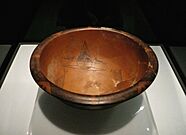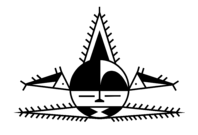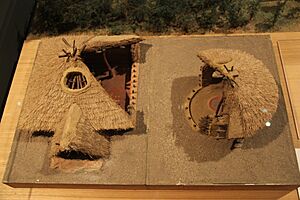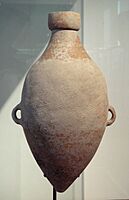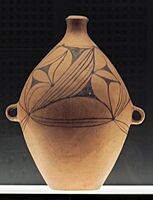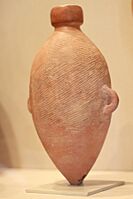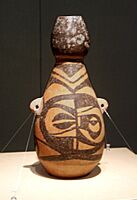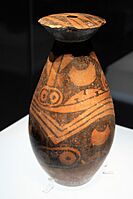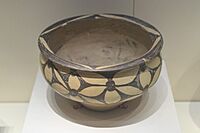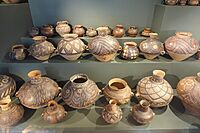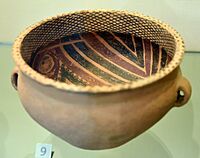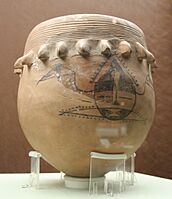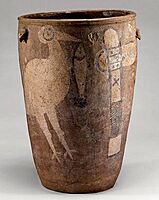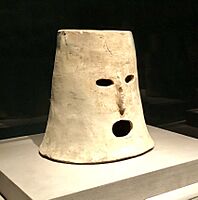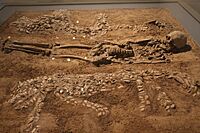Yangshao culture facts for kids
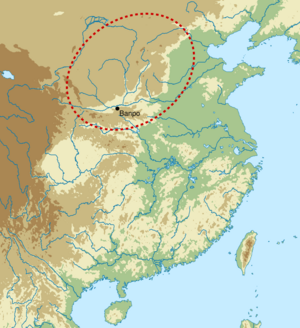 |
|||||||
| Geographical range | Middle reaches of Yellow River | ||||||
|---|---|---|---|---|---|---|---|
| Period | Neolithic | ||||||
| Dates | c. 5000 – c. 3000 BC | ||||||
| Major sites | Shuanghuaishu, Banpo, Jiangzhai | ||||||
| Preceded by | Peiligang culture, Baijia culture, Dadiwan culture, Cishan culture | ||||||
| Followed by | Majiayao (3300–2000 BCE) Longshan culture (3000-1900 BCE) |
||||||
| Chinese name | |||||||
| Chinese | 仰韶文化 | ||||||
|
|||||||
The Yangshao culture (Chinese: 仰韶文化; pinyin: Yǎngsháo wénhuà) was an ancient group of people who lived in China a very long time ago. They were part of the Neolithic period, which means they used stone tools and started farming. This culture existed along the middle part of the Yellow River in China. They lived there from about 5000 BC to 3000 BC.
The culture is named after a place called Yangshao. This was the first site where archaeologists found signs of this ancient group. It was discovered in 1921 by a Swedish scientist named Johan Gunnar Andersson. The Yangshao culture was strongest in the Henan province, and also in nearby areas like Shaanxi and Shanxi.
Contents
Life in the Yangshao Culture
What They Ate
The main food for the Yangshao people was a grain called millet. Some groups grew foxtail millet, while others grew proso millet. They also found some signs that they ate rice.
People are still debating how the Yangshao people farmed. Some think they used a method called "slash-and-burn." This means they would cut down plants, burn them, and then plant crops in the rich soil. Once the soil was used up, they would move to a new area. Other experts believe they farmed in the same fields for a long time.
The Yangshao people also kept animals like pigs and dogs. They rarely had sheep, goats, or cattle. They also hunted and fished to get meat. They used special stone tools for these activities.
Amazing Crafts
The Yangshao people were very skilled at making pottery. They created beautiful pots and bowls using white, red, and black colors. Their pottery often had designs of human faces, animals, or geometric shapes.
Unlike later cultures, the Yangshao people did not use a pottery wheel. They shaped their pottery by hand. Archaeologists even found that children were sometimes buried in these painted pottery jars. The style of Yangshao pottery spread to other cultures and regions.
The Yangshao culture also produced a small amount of silk. They also wove hemp into cloth. Men wore simple loin clothes and tied their hair on top of their heads. Women wrapped cloth around themselves and wore their hair in a bun.
How They Built Homes
Yangshao houses were built by digging a round or rectangular hole about one meter deep. The walls of this pit were made strong by pressing down the earth. Then, they wove a frame of branches, called wattle, over the pit. They covered this frame with mud. The floor was also made firm by pressing down the earth.
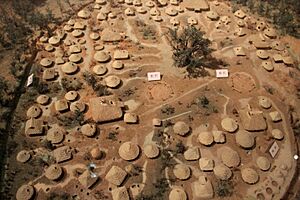
Next, they placed short poles around the top of the pit. More branches were woven onto these poles and covered with mud. A frame of poles was then set up to make a cone-shaped roof. These poles also helped support the roof. Finally, the roof was covered with millet stalks.
Inside the houses, there wasn't much furniture. There was usually a shallow fireplace in the middle with a small stool. A bench might be along the wall, and a bed was made of cloth. Food and other items were placed or hung on the walls. Outside, they built small pens for their animals.
Yangshao villages were usually about ten to fourteen acres in size. They had houses built around a central open area.
Society and Beliefs
Experts have different ideas about how Yangshao society was organized. Some thought it was a "matriarchal" society, meaning women held the main power. Others believe it was changing from a matriarchal to a "patriarchal" society, where men had more power. Still others think it was already patriarchal. These ideas come from studying how people were buried.
A very old statue of a dragon was found from the Yangshao culture. It dates back to about 5000 BC. This makes it the oldest known picture of a dragon in the world! Even today, Chinese people still respect and worship dragons.
Important Yangshao Sites
The town of Yangshao in Henan province is where the culture got its name. There is a museum next to the archaeological site there.
Another famous Yangshao village is Banpo, near Xi'an. This village was surrounded by a ditch. Another large village called Jiangzhai was also completely surrounded by a ditch. At both Banpo and Jiangzhai, archaeologists found marks carved on pottery. Some people think these might be early numbers or even a very old form of Chinese characters. However, not everyone agrees with this idea.
Different Time Periods of Yangshao
The Yangshao culture is usually divided into three main time periods:
- The Early Yangshao period, also called the Banpo phase, lasted from about 5000 BC to 4000 BC. Important sites from this time include Banpo, Jiangzhai, and Dadiwan in the Wei River valley.
- The Middle Yangshao period, or Miaodigou phase, was from about 4000 BC to 3500 BC. During this time, the culture spread out in all directions. In some areas, like western Henan, villages started to become organized in a hierarchy, meaning some were more important than others.
- The Late Yangshao period was from about 3500 BC to 3000 BC. During this time, the village hierarchies became even more common. The first wall made of rammed earth in China was built around a large settlement called Xishan.
The Majiayao culture to the west is now seen as a separate culture. It developed from the middle Yangshao culture.
Artifacts
- Ceramics
Images for kids
See also
- List of Neolithic cultures of China
- Dawenkou culture
- Hemudu culture
- Majiayao culture
- Majiabang culture
- Hongshan culture
- Beifudi
- Xishuipo


